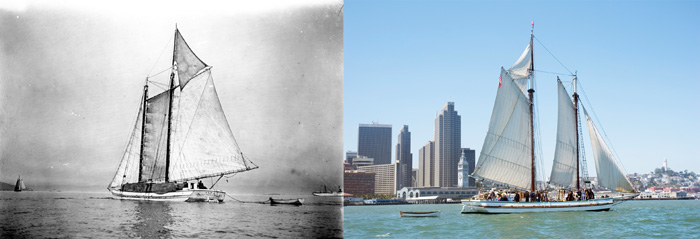All over the world, sailing craft have evolved to meet the specific needs of particular locations. Independent invention responded to those needs—needs that were at the same time generic to all sailing craft and unique to the location and the technology available at the time.

The scow schooner Alma as she looked back in the days when she was working to move cargo on the waterways of the Bay and Delta and as she looks now as part of the historic fleet of vessels at the San Francisco Maritime National Historical Park at the Hyde Street Pier. Photos courtesy of San Francisco Maritime National Historic Park.
By CaptaIn Ray
Published: June, 2012
All over the world, sailing craft have evolved to meet the specific needs of particular locations. Independent invention responded to those needs—needs that were at the same time generic to all sailing craft and unique to the location and the technology available at the time.
Human history is full of examples of these indigenous craft, from the Micronesian proa of the western Pacific to the Dutch skûtsje of northern Europe and the Grand Banks fishing schooners of Nova Scotia. Here on San Francisco Bay, we also have an excellent example of this type of home-grown craft: the scow schooner.
The term scow (in this usage) refers to a wide, flat-bottomed, square-ended craft without a deep keel. Scows were often equipped with a centerboard or leeboards, either of which could be retracted, allowing access to very shallow water. Small scows were used as workboats, while large ones carried cargo.
"Schooner" refers to the arrangement of masts and sails. A schooner has at least two masts, with the forward mast being shorter than or (less frequently) the same height as the aft mast. It is not a common rig today, and ferry riders will have to search long and hard to find one on the Bay. One hundred and twenty years ago, however, scow schooners were everywhere!
During the second half of the 19th century and into the first few decades of the 20th, the easiest (and cheapest) way to move goods was on the waterways of the Bay and Delta. The scow schooner’s shape (think of a shoebox lid) allowed access to water much too shallow for deep draft boats, and scow schooners became the delivery trucks of their day. They were often referred to as "hay scows" because so many of them carried hay to the stables in San Francisco.
But scow schooners carried so much more: Upstream they distributed the goods of the world as well as bulk cargos like lumber, sand and fertilizer. On the return voyages downstream, they carried cargos like coal from Mt. Diablo and the agricultural output of the Central Valley. In total, over 400 scows were built. Today, only the Alma survives—all the rest are gone.
In 1865, Fred Seimer emigrated from Germany and started a shipyard in Hunters Point. He built two scow schooners. The first one he named for his daughter, Adelia, and the second one (built in 1891), he named for her daughter, Alma. The Alma was small by the standards of the day, only 59 feet on deck, although with her bowsprit and overhanging boom aft she is 80 feet overall. She is 22.6 feet wide, draws just four feet of water, and when fully loaded displaces a little more than 41 tons.
For the first 27 years of her life, the Alma hauled hay and lumber. In 1918, her masts were removed, and for the next eight years, she was towed as a barge loaded with salt from Alviso, in the South Bay. In 1926, a new owner installed a gasoline engine and she began hauling oyster shells to Petaluma, where the shells were ground up for chicken feed.
The Alma was retired in 1957, still seaworthy but no longer profitable. The State of California purchased her in 1959 as she sat on the mudflats of Alviso and restored her in the 1960s. Ownership was transferred to the National Park Service in 1978 and the Alma was designated a National Historic landmark in 1988. Still sailing, the Alma is now part of the historic fleet of vessels at the San Francisco Maritime National Historical Park at the Hyde Street Pier.
You can visit her (and many other historic ships) at the park. The summer sailing schedule for the Alma will soon be available on the park’s website, www.nps.gov/safr.
Ray Wichmann, is a US SAILING-certified Ocean Passagemaking Instructor, a US SAILING Instructor Trainer, and a member of US SAILING’s National Faculty. He holds a 100-Ton Master’s License, was a charter skipper in Hawai’i for 15 years, and has sailed on both coasts of the United States, in Mexico, the Caribbean, and Greece. He is presently employed as the Master Instructor at OCSC Sailing in the Berkeley Marina.

